Ineffective heating is one of the two most common causes of snake illness that we see. That makes this page very important!
There are many different ways to heat an enclosure. Some are better than others. We will try to discuss most of them here and explain how and why we set our enclosures the way we do.
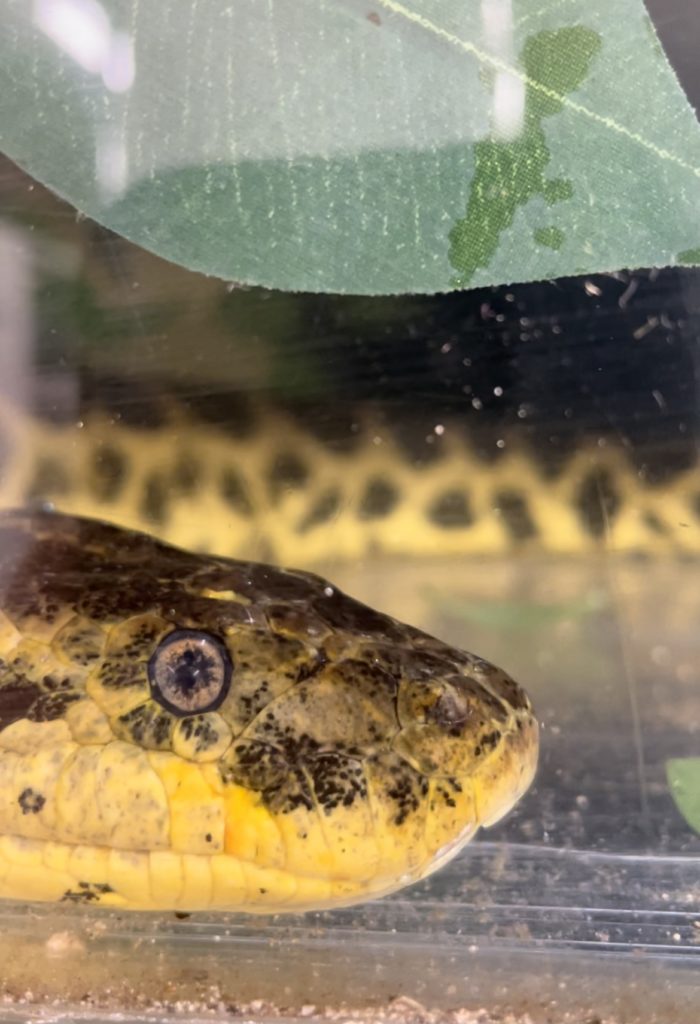
Our anaconda, Toad, made this topic very clear for me. He came to us with severe life threatening injuries. Along with that came a fear of being handled. His pain levels were such that he was very defensive. Handling him daily for wound cleaning and treatments would cause significant stress. Our solution was a custom heated and medicated bath inside his enclosure. The details of this are for a different discussion, but the learning part for this topic was evident when he entered his warm water bath for the first time. He had been sitting under his 95 degree basking spot for several days which we thought meant he was quite warm. However, when we gave him access to his warm water bath his body temperature LOWERED the water from 88 degrees to 74 degrees. That means that even though his enclosure temperature was reading 95 degrees, his true body temperature was much colder than that. Now extrapolate that to a snake who is inside an enclosure that is only 75-80 degrees. That is simply too cold for healthy bodily functions.
Lets keep Toad in mind when we design our enclosure and be extra thorough in making sure the climate is controlled in a way that translates to a warm SNAKE rather than just a warm enclosure.
Belly heat or overhead heat? Both!
Ok – so this is a question we see frequently. We learned from Toad that a snake should be provided with both overhead and belly heat unless they are in a very small enclosure. Snakes that are being housed in tubs, small racks, or enclosures that are 18″ tall or less can do well with only belly heat.
Anything larger than that should have both. This is because just one or the other does not actually transmit that heat to your snake as well as you might think. Your goal in designing the inside climate of your enclosure is to give your snake a basking spot somewhere around 95 degrees, a warm side ambient temperature of 85 degrees, and a cold side ambient temperature of 75 degrees. We achieve that goal by placing a radiant heat panel on the ceiling of the hot side and using heat tape on the floor. In really large enclosures we need THREE thermostats! If you want your snake to be healthy – this is the kind of control you need.
Burns and fire hazards:
Using the heat products needed for these enclosures means you must protect the animal, yourself, and your home from the hazards that go along with them. Electrical heat-producing units of any kind will always come with some amount of risk. They must be installed correctly and controlled in order to be safe.
The following details are a must for lowering these risks:
- Use both thermostats AND thermometers;
- Heater placement must include guards or insulation that prevents the snake from directly touching the heater;
- Ensure correct installation and use of heaters to prevent electrical shorts;
- Protect heaters from contact with water;
- Prevent the snake from dislodging or moving any of the units;
- DAILY WALK THROUGHS – check your enclosures daily to ensure no problems have started. It’s better to prevent a problem than deal with it after it has already occurred.
Below is what a snake with 3rd degree burns looks like. This was caused by a heat pad under a glass aquarium without a thermostat.

Using a thermostat correctly:
It is becoming more well known that thermostats are needed to control your heat products. That is excellent but we still see those thermostats being used in a way that just doesn’t make sense. The two most common mistakes are listed here.
Probe locations: Many people will tell you to place the thermostat probe BETWEEN the heat tape and the enclosure. That means your heat tape gets turned off when the heat tape itself reaches the set temperature. Unfortunately that means the heat does not ever reach your snake. We don’t need to know what temperature our heat tape is. We need to know what temperature our animal is!
We place our thermostat probes on the inside of the enclosure taped to the floor where the animal will be sitting. That means the heat tape will be allowed to transfer it’s heat through the material to where the animal is. You do need to consistently monitor that probe to make sure it doesn’t get dislodged. However, if you plan to keep these animals, it is your responsibility to check things like that daily. We do a walk through twice daily at Snake Haus to look at every enclosure’s thermostat and make adjustments as needed. Do not expect to be able to set up your enclosure and then walk away without monitoring it daily.
Heating multiple enclosures with only ONE thermostat: This is our biggest complaint with rack systems. Most people use one thermostat per rack and the probe is placed under or behind the middle tub. This opens you up to several problems. The first is that a problem with the heaters in any tub except that middle one may result in a fire hazard. The thermostat might not shut the heat off until it’s too late if the fire starts in the top or bottom tub. The other problem is this sort of system often results in the lowest tub being too cold and the highest tub being too hot. Unfortunately it is expensive to have separate thermostats for every tub. Just know that if you choose to run a rack with only one thermostat, as many people do, you are putting your animals at risk.
Types of thermostats:
Reptile-specific thermostats are best because they have better control and safer shut off mechanisms. If you can afford to use these we highly recommend them. Our favorite are Herpstat products at the Bean Farm
We use low cost plant thermostats due to our operating costs. We are not willing to run enclosures without thermostats which means we need 100 thermostats or more at any given time! We can not afford to purchase that many Herpstats. We use these instead and add separate thermometers and regular maintenance checks to be sure they are working properly. These have a wider range of temperature variation which is acceptable for most animals. They do fail on occasion so we monitor them closely for signs of wear and tear and replace them as needed. Plant thermostat on Amazon
Cold side too cold:
Many people don’t pay enough attention to the cold side of their enclosures. Heating your cold side may sound strange but failing to regulate the cold side results in your heaters being over worked. If your enclosure does not have enough heat units to maintain the correct temperature gradients you end up with a cold side that is too cold and a hot side that is too hot.
If the cold side is too cold you end up with the following problems:
- The animal will need to spend more time closer to the heater to stay warm even if the temperature is actually too hot. That is why a snake will get burned. They do not feel heat the way we do and their need to maintain correct core body temperature overrides any sensation of surface heat they feel on their skin. If you find your snake working hard to get closer to it’s heat source, or never leaving their basking spot, that probably means your cold side is too cold. They will climb on top of a heater that is hot enough to burn them (CHE or belly heat) rather than allow themselves to stay too cold.
- If the basking spot is the only place where heat is produced, that heater has to stay on longer and run hotter in order to keep the ambient temperature where you need it. If your enclosure is inside a reptile room that never gets colder than 80 degrees, you will not have this problem until the power goes out. For those of you that are keeping your enclosures in a normal area of your home that is not heated that warm 24/7, then you need to do a little extra work to maintain the cold side. You should not rely on your basking spot heat unit to heat your entire enclosure.
Basking Spot: CHE vs RHP
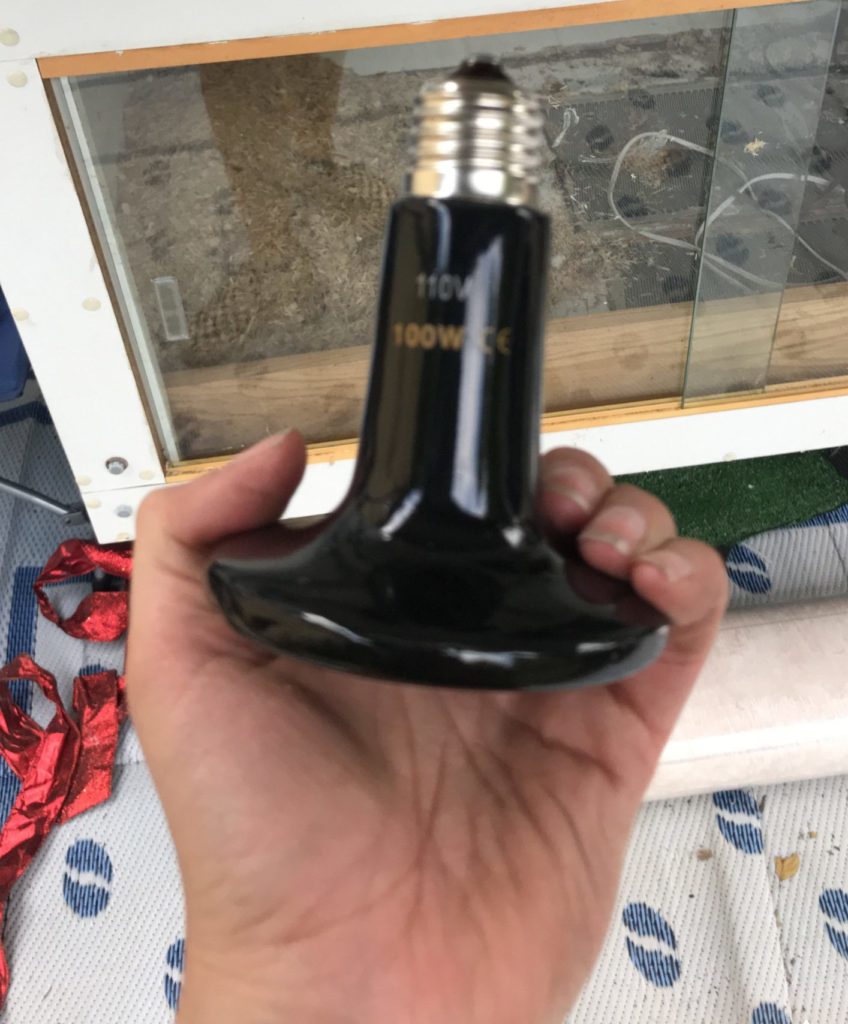
Ceramic heat emitters (CHE) have some advantages. They are very good at producing heat and they are inexpensive. The disadvantages are their effect on humidity and their inherent danger. CHE’s get very hot so pose a much higher risk of causing fires or burns to your animal. Because they are so hot they tend to burn any water moisture out of the air causing higher difficulty in maintaining adequate humidity inside the enclosure. They also take up more room. That does not mean they are a poor choice, but it does mean they are a bit more difficult to use safely. You must have the correct fixture, it must be covered with a guard, and it must not be in close contact with any combustible material. They work well in extremely large enclosures where space is not a problem and you need a large amount of heat produced. For that reason they are common in large lizard enclosures. Unfortunately, they are more challenging in snake enclosures. Follow these links to see what is needed:
Radiant Heat Panels (RHP): These are, in our opinion, the best way to provide your snake a good basking spot. They are more expensive but are much safer for your animal. The following are different types of RHPs that are available. Unfortunately, in recent months they have become harder to find. We have some of each of these panels at Snake Haus and like them all. They each have aspects that are better or worse than the others but your snake will benefit from any one of these three.
- Vivarium Electronics (or RBI): These are the most cost effective but have a significant design flaw that can result in the cord connection failing.
- Pro Products: These are the nicest and most reliable, however, you must order via a phone call rather than convenient online ordering.
- Sweeter Heater: These are a fairly good as well. Their cord connection is safer but lack the ability to disconnect or reconnect a cord for installation.
This picture shows a Vivarium electronics RHP installed. The chains will have a shelf attached to them later and are not part of the heating system. You can also see heat tape on the floor below it.
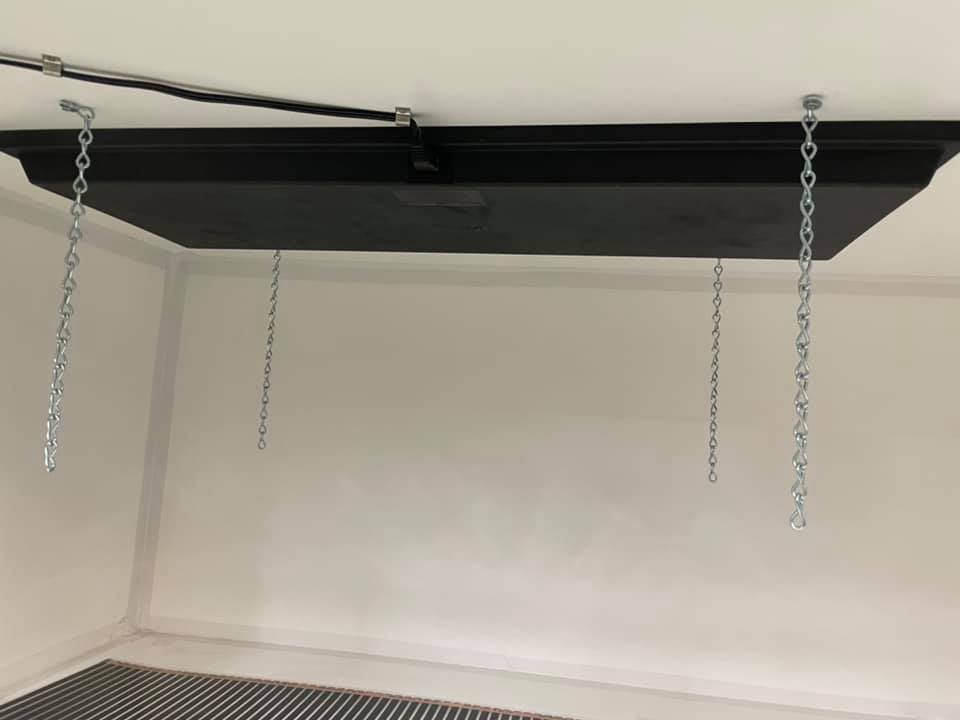
Belly Heat: heat tape, reptile pads, or human heat pads
Heat tape: We use heat tape for belly heat due to having so many enclosures. We save money by building our own belly heat panels out of heat tape but there are other easier options that we will show below. Our favorite local source for heat tape is the Bean Farm. You can purchase it in rolls to make yourself, however that requires some electrical skills. Or you can purchase pre-made heat tape sets to avoid the extra work of installing the wires and plugs. We solder our electrical connections to our heat tape ourselves because well, we can! This actually gives a better connection and is safer than the clips that are made for heat tape. This is also another way we save money. Here you can see a section of heat tape that we just made.
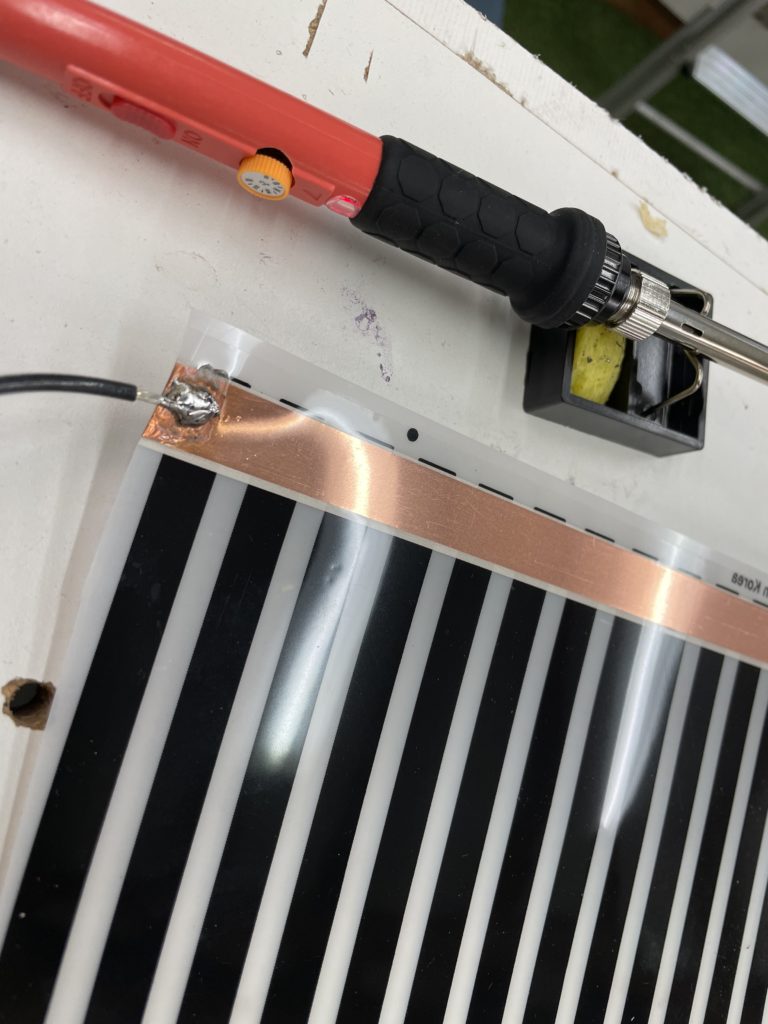
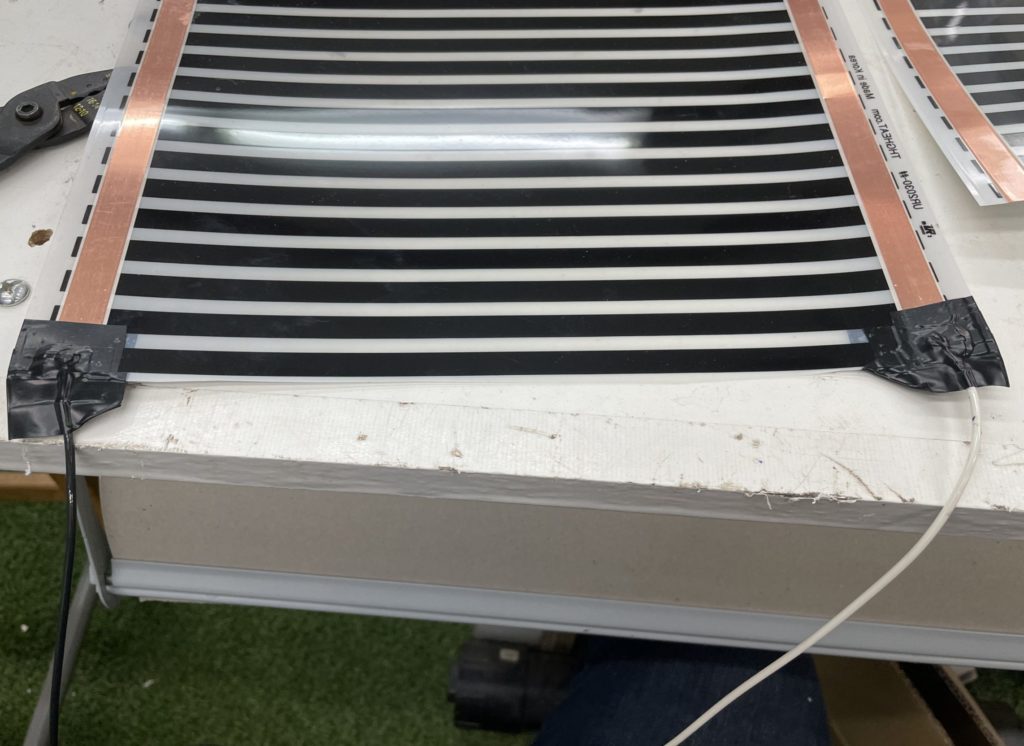
Heat tape is NOT water proof when made with the clips that are sold for it. If you use the clips, you need to be extra careful to keep the heat tape from getting water on it. These clips work by puncturing the plastic coating on the heat tape to give the wires contact. When we solder them we can cover them with electrical tape for extra safety. You can achieve the same level of safety by covering the metal clips with plastic insulators that are also sold with them and then covering those with electrical tape or filling them with silicone. Heat tape clips at the Bean farm
Human heat pads: Actually there are a few human heating pads that can work well for smaller snake enclosures. If you want to use one of these you need to make sure you get one that is water proof and does NOT have a timed off switch. We always keep a few of these around for situations when we need to set up a temporary enclosure in a hurry. Putting one of these under a large plastic tub is a quick and easy way to set up an emergency enclosure. Human heat pad on Amazon
Protect against burns caused by belly heat: I cover the belly heat unit with an insulating and water proof tray made from corrugated plastic. It helps keep the enclosure clean and dry as well as protects the animal from burns by allowing them to sit right on top of their heater without being in direct contact.
Watch this video to see how I set up the heat tape in Viola’s new enclosure:
Airflow
Although airflow is important, we find that most people have TOO MUCH airflow. You need to remember that fresh air vents will allow your heat and humidity to leave the enclosure. If heat and humidity leave the enclosure you must work harder to continually replace them.
The worst example of this are screen top aquariums. Combining a heat pad underneath an aquarium with a screen top, results in strong convection action that carries heat and humidity right out the top. That forcibly draws heat and moisture out of your animal and often results in some of the most unhealthy animals we have ever seen. Then people realized it’s too cold inside the aquarium so they add a CHE on top making it even dryer. Then they see how dry the animal gets and start misting the substrate to boost humidity. That leaves your snake sitting in cold wet substrate and they develop scale rot. Do NOT use screen tops in any enclosure.
The right amount of airflow is needed for your belly heat units. Trapping the heat tape without any airflow raises the risk of combustion. This is one of the reasons we prefer our coroplast trays. This material has air ducts through it which allows the heat to move and circulate. If you are placing your heat tape UNDER your enclosure instead of inside, make sure you have some air flow under it.
If you feel the need to add airflow as a way to mediate troubles with high humidity you should re-evaluate how you are creating the water vapor inside that environment. Visit the Humidity page next.
Heating multiple enclosure as one combined unit:
watch this video to see how we heat large stacks of enclosures.


